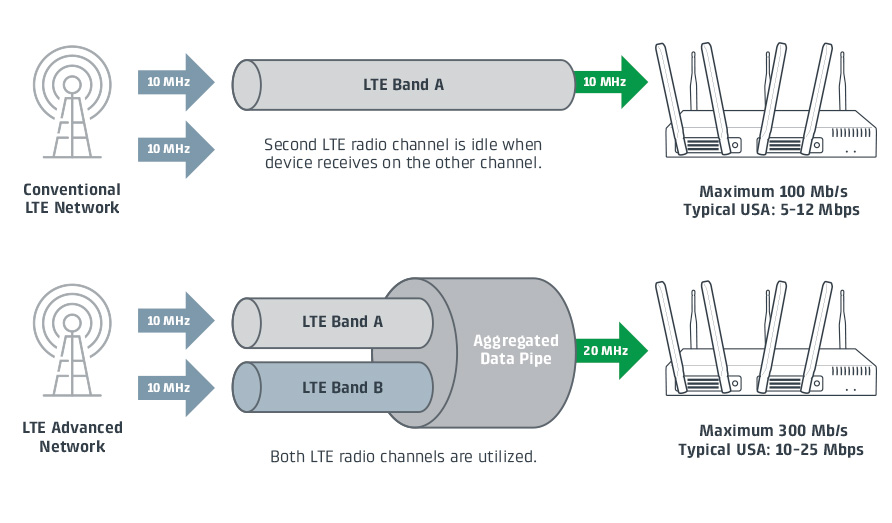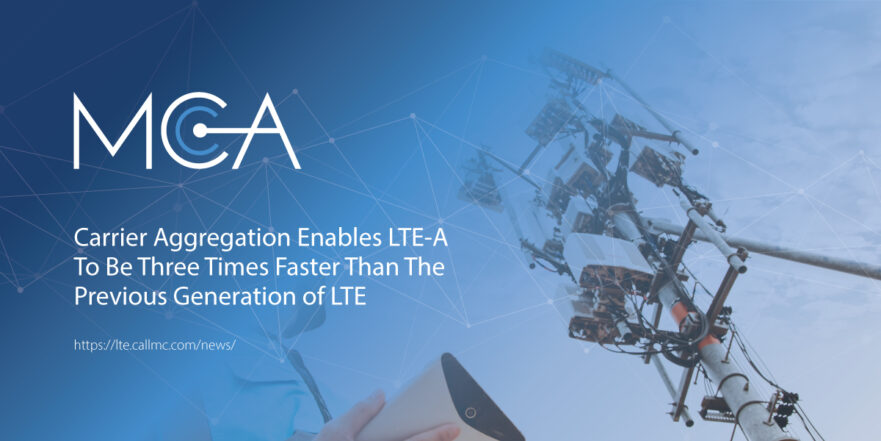Carrier Aggregation Enables LTE-A to be Three Times Faster Than Previous Generation of LTE
Benefits Of LTE Advanced Are Rooted In Carrier Aggregation
Carrier aggregation is the feature on which LTE-A is built, setting it apart from older standards. In conventional LTE networks, carriers broadcast in multiple frequency bands, but each device or 4G router can only utilize a single frequency band at a time. Certain frequency bands may be overtaxed with traffic at any given time, while others remain underutilized. This means the devices are underutilizing the network resources. High-quality-of-service (QoS) might be negatively impacted by high-volume usage on one band within a geographic area or when applications require a lot of bandwidth.
Carrier aggregation allows carriers to transmit data to a device like a wireless router over multiple network bands at once through a single “aggregated data pipe.”
LTE Advanced Offers Better Quality-Of-Service
LTE-A utilizes a more efficient packet scheduling protocol, allowing carriers to manage radio frequency resources flexibly. In other words, the packets of data carried over the network can get where they’re going using more efficient routes, and there’s a lower likelihood that data will be lost in transmission. Network providers can better allocate radio spectrum resources across their network, intelligently selecting which users connect via which frequency bands to enhance quality and capacity despite finite spectrum.
That means businesses that rely on wireless networks can use and create higher-bandwidth applications, enjoy better access to cloud storage and software, and work faster.
LTE Advanced Is More Reliable
With single-band LTE, connectivity can be interrupted for a few seconds when a device switches frequency bands. In contrast, devices switch frequency bands in just a few milliseconds because LTE-A utilizes multiple frequency bands simultaneously. Additionally, even if one band drops, the device stays connected via the second band in the aggregated data pipe.
Organizations can trust LTE-A to provide connectivity for even their most mission-critical applications.
Carriers Are Using LTE-A And Small Cells To Address Data Demand
While traditional LTE is already widely recognized by mobile and distributed enterprises as a critical business enabler, one potential drawback is the potential for radio spectrum interference in densely crowded areas like urban centers and stadiums. Additionally, the demand for data is growing exponentially. Today, cellular carriers are aggressively deploying small-cell radio access nodes in many urban centers in concert with their efforts to expand their LTE-A coverage. These small-cell nodes have a short range but help increase network capacity and decrease congestion.
This move by carriers will allow enterprises to continue the shift to wireless networking. Carriers will be better able to meet the rapidly increasing demand for wireless bandwidth.
LTE-A Is Three Times Faster Than The Previous Generation Of LTE
You may wonder whether LTE-A can significantly improve network performance. The answer is yes, thanks to carrier aggregation.
On single-band LTE, there are speeds of about 4 Mbps. During a test in Boise, the LTE-A service speed was measured, and was able to reach speeds more than three times faster — 15 Mbps. Across the U.S. trend is similar: with conventional LTE, typical speeds range from 5-12 Mbps, while LTE-A offers advertised speeds of 10-25 Mbps. There have been reports of speed tests using some routers, including Cradlepoint, at 60 Mbps, 80 Mbps, and even up to 156 Mbps on commercial networks in the U.S.

LTE Advanced Is Available Across The US
Frequently Asked Questions About LTE-A
About MCA and Our CNS Team
MCA is one of the largest and most trusted integrators in the United States, offering world-class voice, data, and security solutions that enhance the quality, safety, and productivity of customers, operations, and lives. More than 65,000 customers trust MCA to provide carefully researched solutions for a safe, secure, and more efficient workplace.
Our Cellular Networking Solutions (CNS) team (formerly known as USAT) is made up of certified experts in designing and deploying fixed and mobile wireless data connectivity solutions for public and private enterprises nationwide - complete with implementation, training, proof of concept (POC), system auditing, and on-site RF surveying services with optional engineering maintenance contracts.
Our extensive catalog of world-class routers, gateways, and software designed for remote monitoring and management in even the harshest environments allows us to deliver a full suite of reliable technologies capped with a service-first approach.
Share this Post














